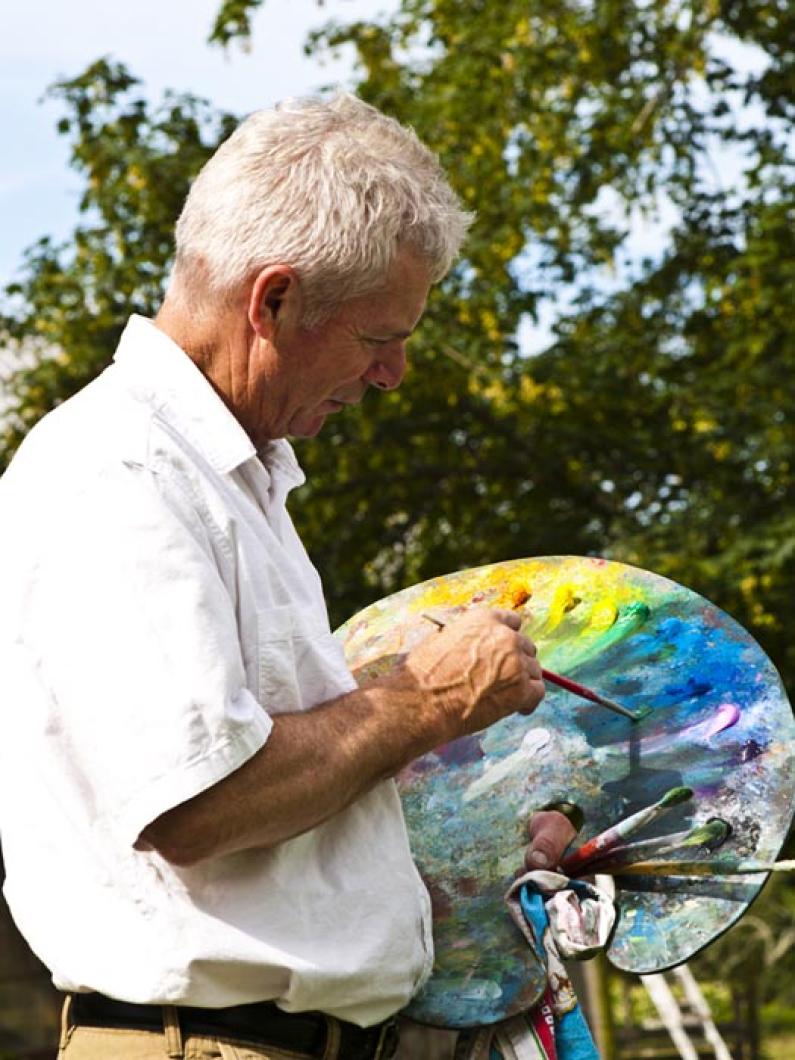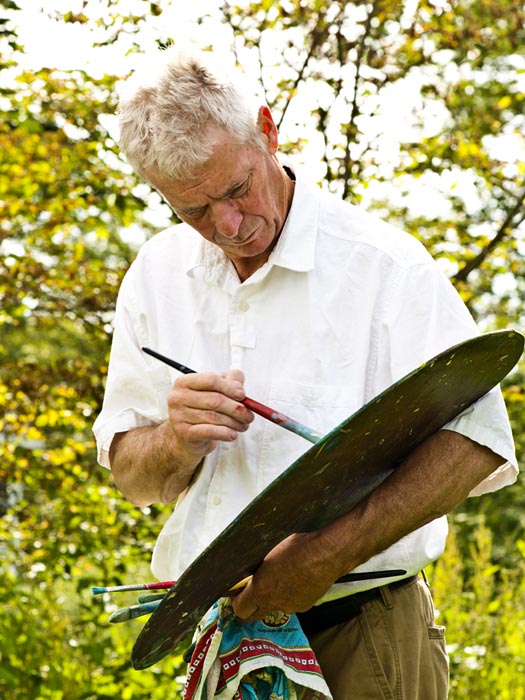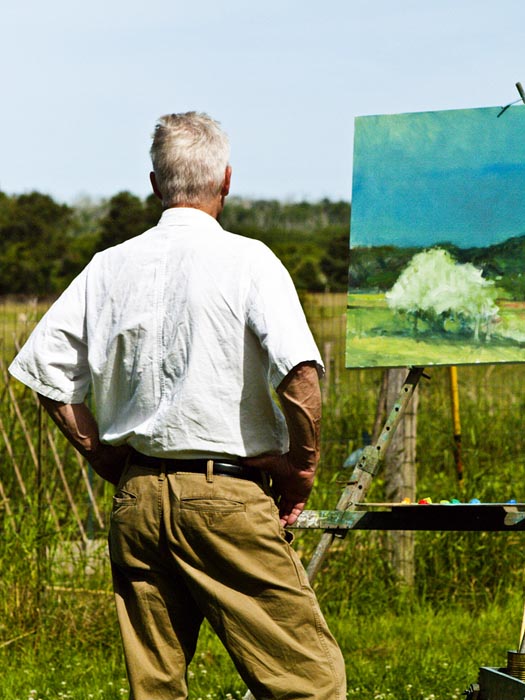This sunny Saturday in West Tisbury, Allen Whiting is out at his easel, working at his latest landscape and simultaneously working at his answers to questions about his art.
His approach to both tasks is similar: He goes at it enthusiastically for awhile, then pauses to reconsider things, then goes back and adds another layer.
Ask, for example, why an artist who seldom shows outside his own gallery has decided to put on a retrospective of his work at Featherstone Center for the Arts, and he gives a succession of answers.
First up, he is glib.
“Why am I doing it? It’s probably an obsessive need to have my face before the public,” he says.
But that primary-colors, ego response is just a joke. When he begins to consider more seriously his motivations, the answer is more self-deprecating.
“I’m really not sure. It’s been a quizzical thing for me. Do I think I have something to say that other people don’t have to say? I believe in the work, but why do I think anybody needs to look at my crap. That’s the question.”
The third response is the diplomatic one — he wanted to help out Featherstone.
“I’ve grown to like Featherstone,” he says.
The fact is, when the place first started up, 15 years ago, he was already well on his way as an artist, and “pooh-poohed the idea of such art associations.
“But I go there myself now and draw once in awhile. It’s nice and Anne Gallagher is an energetic shaker and a mover and she’s been a patron of mine for many years. She’s just been so supportive.
“She runs the drawing class — for lack of a better word, because no one tells anyone what to do — and she hires the models and ensures they get paid and so on.
“She does that in memory of [the late sculptor and Field Gallery owner] Tom Maley. And she asked me if I would do a show.”
But there is more to it than that, too.
Mr. Whiting is pushing 65, and he had been thinking for some time about doing some kind of retrospective show. Featherstone’s 15th anniversary provided an opportunity for him to present not only his past work but to do something quite different from the usual shows at his gallery.
It will not, for a start, be a commercial exercise; most are not for sale, although there will be a backroom selection of a few oils and drawings, books and posters.
Second, all but one of the pieces on show come from his private collection.
“I didn’t want anything people have seen before,” he says.
Third and most significant, it will be a very diverse show. Mr. Whiting is primarily known as a landscape painter, but those who have been into the barn on his property know he does a lot more than that.
And at Featherstone, the majority of the works on display will be that “other stuff.”
“There will be more portraits than you might imagine,” says Mr. Whiting.
“There will be about 40 pieces in all, spanning about 40 years — about 30 paintings and about a dozen sculptures, found object assemblages, old family detritus I picked up off the ground around here and different places.
“You know the game, you take two separate objects and put them together, and end up with a third meaning,” he says.
The exhibition might have been even more expansive, but the space constraints of Featherstone, he says ended up having “dictatorial power over what went in.”
Not that he is all that fussed about it.
“You know, I’ll be 65 next month, and I feel quite liberated. I feel like I can say what I want. If it’s not pressing or permanent it doesn’t really matter. People just want to be entertained; I do, when I go to an art show. It should be fun.”
The Featherstone show is not the only departure from tradition for Mr. Whiting this year. He is not doing the big opening of his gallery this time around either.
“I just didn’t want to do another,” he says. “They just got too huge, too expensive, too hard on the family. My wife and kids were really putting out, getting the place ready, doing all this entertaining. We had to have extra insurance, 400 people would turn up . . .
“I was very flattered as a painter to have to hire a traffic cop. It was fun. The women were dressed pretty and the work was fresh and it was spring. But after awhile people don’t come because it’s too crowded and you can’t see the painting.”
This year, he says, he sent out cards to loyal patrons, informing them the gallery would be open from Memorial Day, on weekends, then regular summer hours after the end of June.
“I suppose it all pushes more towards the art,” he said.
“At 65, what have I got left? Ten, twelve [years]? I want to get painting as much as I can.
“I want to show what I have to show and make enough to get by and not have to dance too much.”
As for the art, he is doing a few different things too. Currently he is working on a picture of his son, at work restoring an ancient barn on the farm. And he is doing it from — quelle horreur — a photograph.
It’s not the way he usually does things, and he would never do a landscape that way. When painting nature, he wants to be in nature.
But in this case, well, his son clearly could not pose for hours halfway up a ladder.
“Degas said making a painting is like committing a good crime. Anything is okay, whatever it takes,” he says.
The trick is to avoid the trap of producing something that looks like a photograph. Too often, he says, photo-realistic painting, “is so right it impresses, but there’s not a lot of life in it.
“I want to get it accurate but I want to keep it soft and have emotion in it.”
Although he has painted portraits, in the traditional sense of creating likenesses, he admits he struggles with them.
“As long as it’s a decent painting of someone, that’s okay with me. I’m after the truth, but it’s any truth at all. Anything that speaks to me I’m happy with,” he says.
There are advantages to working from a photo, though. For one, you can do it anytime, in a controlled environment, taking up exactly where you left off your lasting painting session.
Plein air landscapes, on the other hand, can be frustrating because nature moves, seasons change, and there are bugs.
The landscape he is painting as we talk, for example, is being reworked for the third time. He first began the view, across a field on his property in West Tisbury, in the early spring. It was a sunny day, a bush in the middle of the scene was in bloom and early leaf, with a sheep in front of it.
At his next attempt, the weather had changed and it was not sunny. The leaves had grown out, the colors had darkened. Then he had problem with gnats, which stuck to the work, and he had to remove some paint removing them.
By last Saturday, most of the flowers had gone, as had the sheep. Two horses had wandered into the scene in the middle distance. (The sheep will stay; the horses beautiful as they are, will not go in.)
But those changes don’t really matter to him. More important is to capture the essence of the scene, the season, the place his family has lived for generations.
And, regardless of the other things he does, those landscapes remain the focus of his work.
“Portraits and that other stuff are fun,” he says, “but I seem to like to just go off by myself and paint landscapes.
“This is my comfort zone.”
An artist’s reception for Allen Whiting is on Sunday, July 3, from 4 to 6 p.m. at Featherstone on Barnes Road in Oak Bluffs. For details, call 508-693-1850.








Comments
Comment policy »